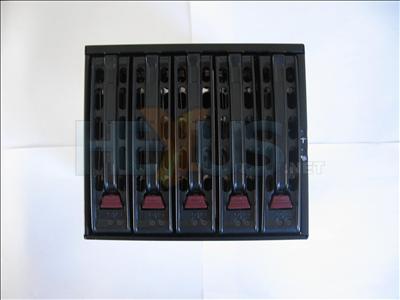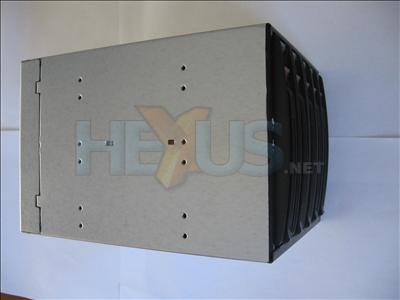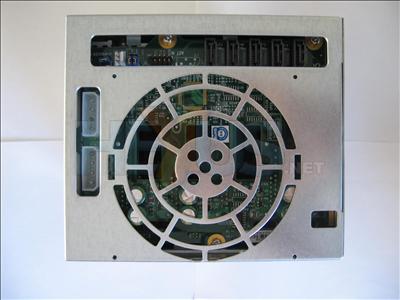Supermicro SATA M35 enclosure
First, we'll have a little look at the enclosure.
From the front the five drive cages can be seen. The dark red buttons release the disk retrieval arms (I just made that name up, but it sounds cool, doesn't it?) Each cage has two lenses for two LEDs, one indicating disk activity (which you can see in this photo) and the other disk failure. The latter doesn't appear to function on the SATA model, only working on the SCSI version. To the right of the picture are two more LED lenses for fan and temperature warning signals, respectively.
The holes on the side of the enclosure give away that it'll fit into three 5.25" drive bays. Of course, those bays can't have any runners between them, like in many cases, as they'd get in the way.
Around the back, power is provided through two four-pin Molex connectors. Five drives will consume a fair amount of current (depending on their spec), so hooking up Molex connectors from two separate runs would be advisable.
Along the top, five SATA connectors can be seen, one for each drive. To the left, a number of blue jumpers are visible. These allow configuration of fan-sensing, buzzer-sounding and the overheat threshold. You may also have guessed that a fan attaches to this enclosure, and indeed it has an 80mm fan and the enclosure has a 3-pin header for it. It's quite noisy and makes the overall unit quite deep, but, then again, it is designed for server chassis and is trying to cool a dense storage array.
The cages are fairly basic and a little bit wobbly when no drive is fitted. However, they're made of aluminium, making them light and helping to conduct heat away from the drives.
There are vents at the front of the cages to let sufficient air through to cool the drives, and installation of the cages into the enclosure is a very smooth operation, as is their removal. The built-in alarm, while ear-piercing, sure does its job in the event of fan failure or overheat condition. If you can get hold of one of these, or something like it, then it'd make a great basis for a NAS home build.














